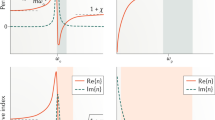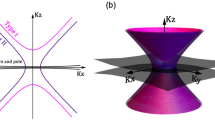Abstract
The recently emerged fields of metamaterials and transformation optics promise a family of exciting applications such as invisibility, optical imaging with deeply subwavelength resolution and nanophotonics with the potential for much faster information processing. The possibility of creating optical negative-index metamaterials (NIMs) using nanostructured metal–dielectric composites has triggered intense basic and applied research over the past several years1,2,3,4,5,6,7,8,9,10. However, the performance of all NIM applications is significantly limited by the inherent and strong energy dissipation in metals, especially in the near-infrared and visible wavelength ranges11,12. Generally the losses are orders of magnitude too large for the proposed applications, and the reduction of losses with optimized designs seems to be out of reach. One way of addressing this issue is to incorporate gain media into NIM designs13,14,15,16. However, whether NIMs with low loss can be achieved has been the subject of theoretical debate17,18. Here we experimentally demonstrate that the incorporation of gain material in the high-local-field areas of a metamaterial makes it possible to fabricate an extremely low-loss and active optical NIM. The original loss-limited negative refractive index and the figure of merit (FOM) of the device have been drastically improved with loss compensation in the visible wavelength range between 722 and 738 nm. In this range, the NIM becomes active such that the sum of the light intensities in transmission and reflection exceeds the intensity of the incident beam. At a wavelength of 737 nm, the negative refractive index improves from −0.66 to −1.017 and the FOM increases from 1 to 26. At 738 nm, the FOM is expected to become macroscopically large, of the order of 106. This study demonstrates the possibility of fabricating an optical negative-index metamaterial that is not limited by the inherent loss in its metal constituent.
This is a preview of subscription content, access via your institution
Access options
Subscribe to this journal
Receive 51 print issues and online access
$199.00 per year
only $3.90 per issue
Buy this article
- Purchase on Springer Link
- Instant access to full article PDF
Prices may be subject to local taxes which are calculated during checkout




Similar content being viewed by others
References
Veselago, V. G. The electrodynamics of substances with simultaneously negative value of ε and µ. Sov. Phys. Usp. 10, 509–514 (1968)
Pendry, J. B. Negative refractive makes a perfect lens. Phys. Rev. Lett. 85, 3966–3969 (2000)
Shalaev, V. M. et al. Negative index of refraction in optical metamaterials. Opt. Lett. 30, 3356–3358 (2005)
Pendry, J. B., Schurig, D. & Smith, D. R. Controlling electromagnetic fields. Science 312, 1780–1782 (2006)
Soukoulis, C. M., Linden, S. & Wegener, M. Negative refractive index at optical wavelengths. Science 315, 47–49 (2007)
Valentine, J. et al. Three-dimensional optical metamaterial with a negative refractive index. Nature 455, 376–379 (2008)
Zhang, S. et al. Experimental demonstration of near-infrared negative-index metamaterials. Phys. Rev. Lett. 95, 137404 (2005)
Shalaev, V. M. Optical negative-index metamaterials. Nature Photon. 1, 41–48 (2006)
Tsakmakidis, K. L., Boardman, A. D. & Hess, O. ‘Trapped rainbow’ storage of light in metamaterials. Nature 450, 397–401 (2007)
Kildishev, A. V. & Shalaev, V. M. Engineering space for light via transformation optics. Opt. Lett. 33, 43–45 (2008)
Pinchuk, A., Kreibig, U. & Hilger, A. Optical properties of metallic nanoparticles: influence of interface effects and interband transitions. Surf. Sci. 557, 269–280 (2004)
Drachev, V. P. et al. The Ag dielectric function in plasmonic metamaterials. Opt. Exp. 16, 1186–1195 (2008)
Noginov, M. A. et al. Enhancement of surface plasmons in an Ag aggregate by optical gain in a dielectric medium. Opt. Lett. 31, 3022–3024 (2006)
Ramakrishna, S. A. & Pendry, J. B. Removal of absorption and increase in resolution in a near-field lens via optical gain. Phys. Rev. B 67, 201101 (2003)
Klar, T. A., Kildisher, A. V., Drachev, V. P. & Shalaev, V. M. Negative-index metamaterial: going optical. IEEE J. Sel. Top. Quantum Electron. 12, 1106–1115 (2006)
Sarychev, A. K. & Tartakovsky, G. Magnetic plasmonic metamaterials in actively pumped host medium and plasmonic nanolaser. Phys. Rev. B 75, 085436 (2007)
Stockman, M. I. Criterion for negative refraction with low optical losses from a fundamental principle of causality. Phys. Rev. Lett. 98, 177404 (2007)
Kinsler, P. & McCall, M. W. Causality-based criteria for a negative refractive index must be used with care. Phys. Rev. Lett. 101, 167401 (2008)
Wegener, M. et al. Toy model for plasmonic metamaterial resonances coupled to two-level system gain. Opt. Exp. 16, 19785–19788 (2008)
Fang, A., Koschny, Th., Wegener, M. & Soukoulis, C. M. Self-consistent calculation of metamaterial with gain. Phys. Rev. B 79, 241104 (2009)
Zheludev, N. I., Prosvirnin, S. L., Papasimakis, N. & Fedotov, V. A. Lasing spaser. Nature Photon. 2, 351–354 (2008)
Sivan, Y., Xiao, S., Chettiar, U. K., Kildishev, A. V. & Shalaev, V. M. Frequency-domain simulations of a negative-index material with embedded gain. Opt. Exp. 26, 24060–24074 (2009)
Noginov, M. A. et al. Compensation of loss in propagating surface plasmon polariton by gain in adjacent dielectric media. Opt. Exp. 16, 1385–1392 (2008)
Klimov, V. I. et al. Optical gain and stimulated emission in nanocrystal quantum dots. Science 290, 314–317 (2000)
Stockman, M. I. The spaser as a nanoscale quantum generator and ultrafast amplifier. J. Opt. 12, 024004 (2010)
Plum, E., Fedotov, V. A., Kuo, P., Tsai, D. P. & Zheludev, N. I. Towards the lasing spaser: controlling metamaterial optical response with semiconductor quantum dots. Opt. Exp. 17, 8548–8551 (2009)
Xiao, S. et al. Yellow-light negative-index metamaterials. Opt. Lett. 34, 3478–3480 (2009)
Kriegler, C. E., Rill, M. S., Linden, S. & Wegener, M. Bianisotropic photonic metamaterials. IEEE J. Sel. Top. Quantum Electron. 16, 367–375 (2010)
Fromm, D. P. et al. Exploring the chemical enhancement for surface-enhanced Raman scattering with Au bowtie nanoantennas. J. Chem. Phys. 124, 061101 (2006)
Lezec, H. J., Dionne, J. A. & Atwater, H. A. Negative refraction at visible frequencies. Science 316, 430–432 (2007)
Cai, W. et al. Metamagnetics with rainbow colors. Opt. Exp. 15, 3333–3341 (2007)
Ku, Z., Dani, K. M., Upadhya, P. C. & Brueck, S. R. Bianisotropic negative-index metamaterial embedded in a symmetric medium. J. Opt. Soc. Am. B 26, B34–B38 (2009)
Jackson, J. D. Classical Electrodynamics Ch. 7.10 (Wiley, 1975)
Cook, J. J. H., Tsakmakidis, K. L. & Hess, O. Ultralow-loss optical diamagnetism in silver nanoforests. J. Opt. A 11, 114026 (2009)
Kildishev, A. V. et al. Negative refractive index in optics of metal-dielectric composites. J. Opt. Soc. Am. B 23, 423–433 (2006)
Acknowledgements
This work was supported in part by ARO-MURI awards 50342-PH-MUR and W911NF-09-1-0539 and by NSF PREM grant no. DMR 0611430. The authors acknowledge valuable discussions with T. Klar. V.M.S. is grateful to Y. Sivan and Z. Jacob for their comments.
Author information
Authors and Affiliations
Contributions
S.X. fabricated the samples and conducted optical characterization and part of the numerical simulations; S.X. and V.P.D. assembled the set-up; V.P.D. guided the optical experiments and partly the numerical simulations and fabrication; A.V.K. guided the numerical simulations and developed a sample-specific analytical technique for retrieving the bianisotropic parameters; A.V.K. and X.N. performed numerical simulations; U.K.C. performed part of the numerical simulations and implemented parallelism in the design and retrieval optimization; H.-K.Y. suggested and developed the original fabrication approach; S.X., V.P.D., A.V.K., X.N. and V.M.S. wrote the manuscript; V.M.S. led the project and discussed the fabrication, optical characterization and numerical modelling.
Corresponding author
Ethics declarations
Competing interests
The authors declare no competing financial interests.
Supplementary information
Supplementary Figures
This file contains Supplementary Figures 1-3 with legends. (PDF 146 kb)
Rights and permissions
About this article
Cite this article
Xiao, S., Drachev, V., Kildishev, A. et al. Loss-free and active optical negative-index metamaterials. Nature 466, 735–738 (2010). https://doi.org/10.1038/nature09278
Received:
Accepted:
Issue Date:
DOI: https://doi.org/10.1038/nature09278
This article is cited by
-
The second-order coherence analysis of number state propagation through dispersive non-Hermitian multilayered structures
Scientific Reports (2024)
-
Optical Tellegen metamaterial with spontaneous magnetization
Nature Communications (2024)
-
Frequency-hopping wave engineering with metasurfaces
Nature Communications (2024)
-
Compensating losses in polariton propagation with synthesized complex frequency excitation
Nature Materials (2024)
-
Hydrogel muscles powering reconfigurable micro-metastructures with wide-spectrum programmability
Nature Materials (2023)
Comments
By submitting a comment you agree to abide by our Terms and Community Guidelines. If you find something abusive or that does not comply with our terms or guidelines please flag it as inappropriate.



